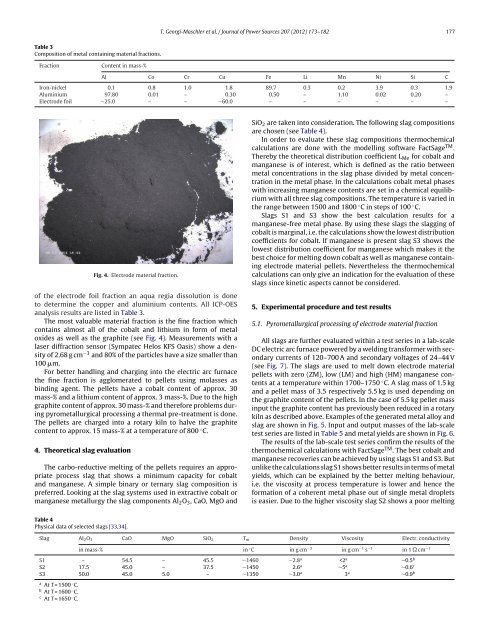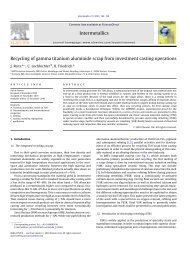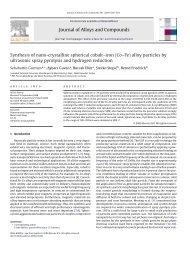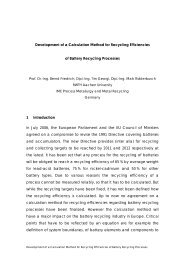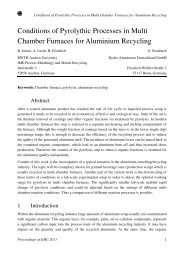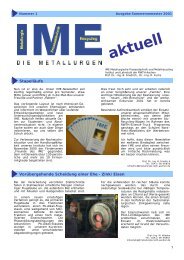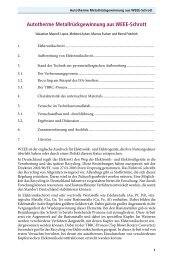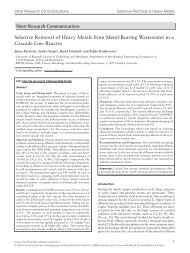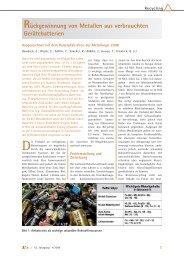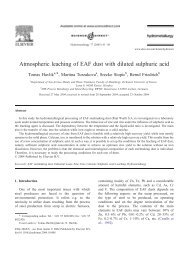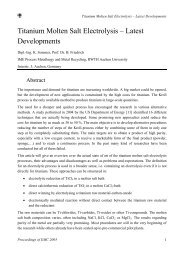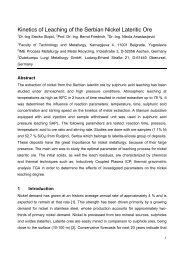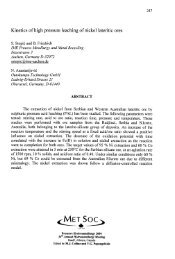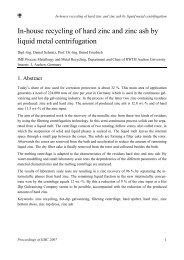Development of a recycling process for Li-ion batteries
Development of a recycling process for Li-ion batteries
Development of a recycling process for Li-ion batteries
- No tags were found...
Create successful ePaper yourself
Turn your PDF publications into a flip-book with our unique Google optimized e-Paper software.
T. Georgi-Maschler et al. / Journal <strong>of</strong> Power Sources 207 (2012) 173–182 177<br />
Table 3<br />
Composit<strong>ion</strong> <strong>of</strong> metal containing material fract<strong>ion</strong>s.<br />
Fract<strong>ion</strong> Content in mass-%<br />
Al Co Cr Cu Fe <strong>Li</strong> Mn Ni Si C<br />
Iron-nickel 0.1 0.8 1.0 1.8 89.7 0.3 0.2 3.9 0.3 1.9<br />
Aluminium 97.80 0.01 – 0.30 0.50 – 1.10 0.02 0.20 –<br />
Electrode foil ∼25.0 – – ∼60.0 – – – – – –<br />
Fig. 4. Electrode material fract<strong>ion</strong>.<br />
<strong>of</strong> the electrode foil fract<strong>ion</strong> an aqua regia dissolut<strong>ion</strong> is done<br />
to determine the copper and aluminium contents. All ICP-OES<br />
analysis results are listed in Table 3.<br />
The most valuable material fract<strong>ion</strong> is the fine fract<strong>ion</strong> which<br />
contains almost all <strong>of</strong> the cobalt and lithium in <strong>for</strong>m <strong>of</strong> metal<br />
oxides as well as the graphite (see Fig. 4). Measurements with a<br />
laser diffract<strong>ion</strong> sensor (Sympatec Helos KFS Oasis) show a density<br />
<strong>of</strong> 2.68 g cm −3 and 80% <strong>of</strong> the particles have a size smaller than<br />
100 m.<br />
For better handling and charging into the electric arc furnace<br />
the fine fract<strong>ion</strong> is agglomerated to pellets using molasses as<br />
binding agent. The pellets have a cobalt content <strong>of</strong> approx. 30<br />
mass-% and a lithium content <strong>of</strong> approx. 3 mass-%. Due to the high<br />
graphite content <strong>of</strong> approx. 30 mass-% and there<strong>for</strong>e problems during<br />
pyrometallurgical <strong>process</strong>ing a thermal pre-treatment is done.<br />
The pellets are charged into a rotary kiln to halve the graphite<br />
content to approx. 15 mass-% at a temperature <strong>of</strong> 800 ◦ C.<br />
4. Theoretical slag evaluat<strong>ion</strong><br />
The carbo-reductive melting <strong>of</strong> the pellets requires an appropriate<br />
<strong>process</strong> slag that shows a minimum capacity <strong>for</strong> cobalt<br />
and manganese. A simple binary or ternary slag composit<strong>ion</strong> is<br />
preferred. Looking at the slag systems used in extractive cobalt or<br />
manganese metallurgy the slag components Al 2 O 3 , CaO, MgO and<br />
SiO 2 are taken into considerat<strong>ion</strong>. The following slag composit<strong>ion</strong>s<br />
are chosen (see Table 4).<br />
In order to evaluate these slag composit<strong>ion</strong>s thermochemical<br />
calculat<strong>ion</strong>s are done with the modelling s<strong>of</strong>tware FactSage TM .<br />
Thereby the theoretical distribut<strong>ion</strong> coefficient L Me <strong>for</strong> cobalt and<br />
manganese is <strong>of</strong> interest, which is defined as the ratio between<br />
metal concentrat<strong>ion</strong>s in the slag phase divided by metal concentrat<strong>ion</strong><br />
in the metal phase. In the calculat<strong>ion</strong>s cobalt metal phases<br />
with increasing manganese contents are set in a chemical equilibrium<br />
with all three slag composit<strong>ion</strong>s. The temperature is varied in<br />
the range between 1500 and 1800 ◦ C in steps <strong>of</strong> 100 ◦ C.<br />
Slags S1 and S3 show the best calculat<strong>ion</strong> results <strong>for</strong> a<br />
manganese-free metal phase. By using these slags the slagging <strong>of</strong><br />
cobalt is marginal, i.e. the calculat<strong>ion</strong>s show the lowest distribut<strong>ion</strong><br />
coefficients <strong>for</strong> cobalt. If manganese is present slag S3 shows the<br />
lowest distribut<strong>ion</strong> coefficient <strong>for</strong> manganese which makes it the<br />
best choice <strong>for</strong> melting down cobalt as well as manganese containing<br />
electrode material pellets. Nevertheless the thermochemical<br />
calculat<strong>ion</strong>s can only give an indicat<strong>ion</strong> <strong>for</strong> the evaluat<strong>ion</strong> <strong>of</strong> these<br />
slags since kinetic aspects cannot be considered.<br />
5. Experimental procedure and test results<br />
5.1. Pyrometallurgical <strong>process</strong>ing <strong>of</strong> electrode material fract<strong>ion</strong><br />
All slags are further evaluated within a test series in a lab-scale<br />
DC electric arc furnace powered by a welding trans<strong>for</strong>mer with secondary<br />
currents <strong>of</strong> 120–700 A and secondary voltages <strong>of</strong> 24–44 V<br />
(see Fig. 7). The slags are used to melt down electrode material<br />
pellets with zero (ZM), low (LM) and high (HM) manganese contents<br />
at a temperature within 1700–1750 ◦ C. A slag mass <strong>of</strong> 1.5 kg<br />
and a pellet mass <strong>of</strong> 3.5 respectively 5.5 kg is used depending on<br />
the graphite content <strong>of</strong> the pellets. In the case <strong>of</strong> 5.5 kg pellet mass<br />
input the graphite content has previously been reduced in a rotary<br />
kiln as described above. Examples <strong>of</strong> the generated metal alloy and<br />
slag are shown in Fig. 5. Input and output masses <strong>of</strong> the lab-scale<br />
test series are listed in Table 5 and metal yields are shown in Fig. 6.<br />
The results <strong>of</strong> the lab-scale test series confirm the results <strong>of</strong> the<br />
thermochemical calculat<strong>ion</strong>s with FactSage TM . The best cobalt and<br />
manganese recoveries can be achieved by using slags S1 and S3. But<br />
unlike the calculat<strong>ion</strong>s slag S1 shows better results in terms <strong>of</strong> metal<br />
yields, which can be explained by the better melting behaviour,<br />
i.e. the viscosity at <strong>process</strong> temperature is lower and hence the<br />
<strong>for</strong>mat<strong>ion</strong> <strong>of</strong> a coherent metal phase out <strong>of</strong> single metal droplets<br />
is easier. Due to the higher viscosity slag S2 shows a poor melting<br />
Table 4<br />
Physical data <strong>of</strong> selected slags [33,34].<br />
Slag Al 2O 3 CaO MgO SiO 2 T m Density Viscosity Electr. conductivity<br />
in mass-% in ◦ C in g cm −3 in g cm −1 s −1 in 1 cm −1<br />
S1 – 54.5 – 45.5 ∼1460 ∼2.8 a


